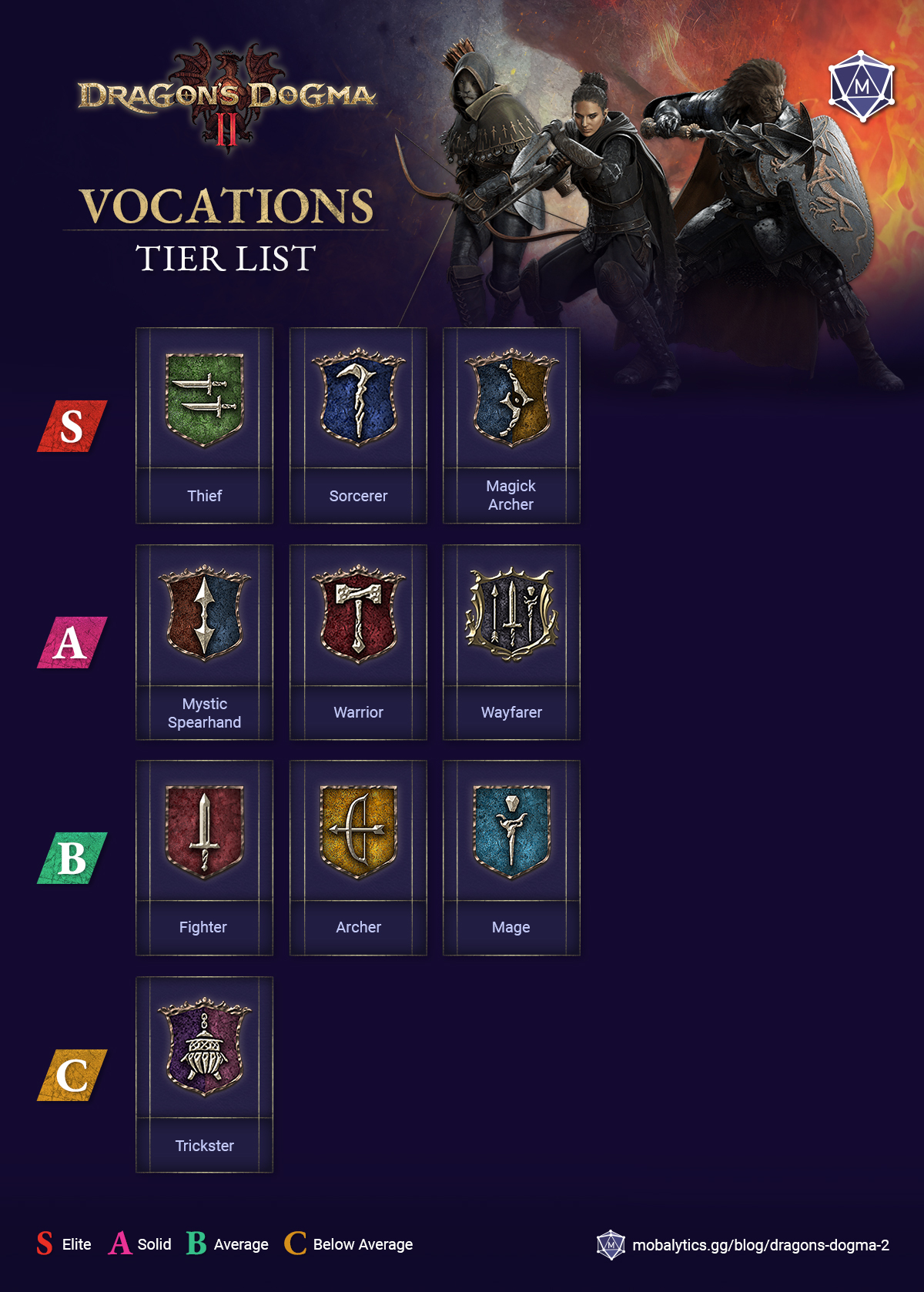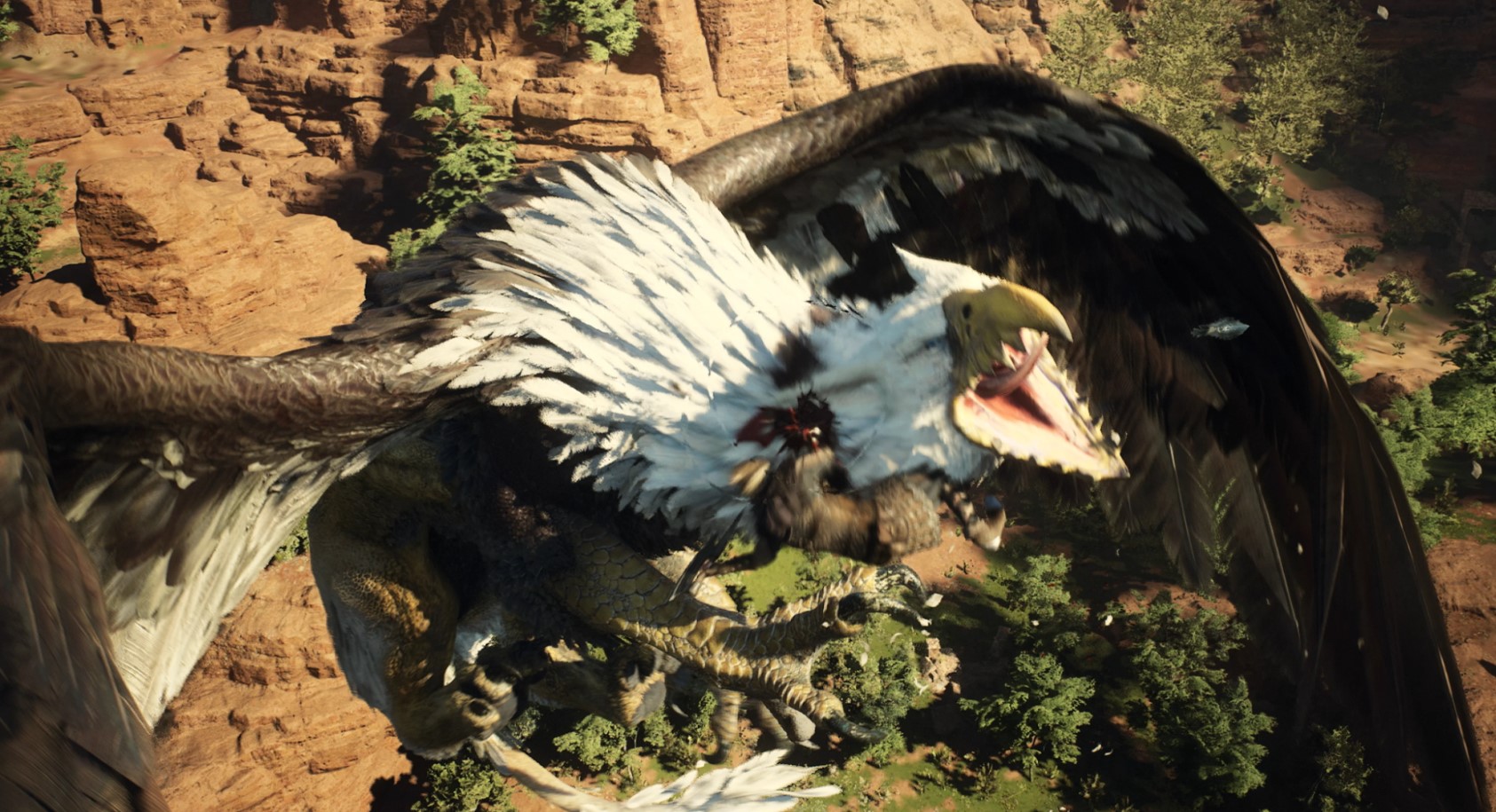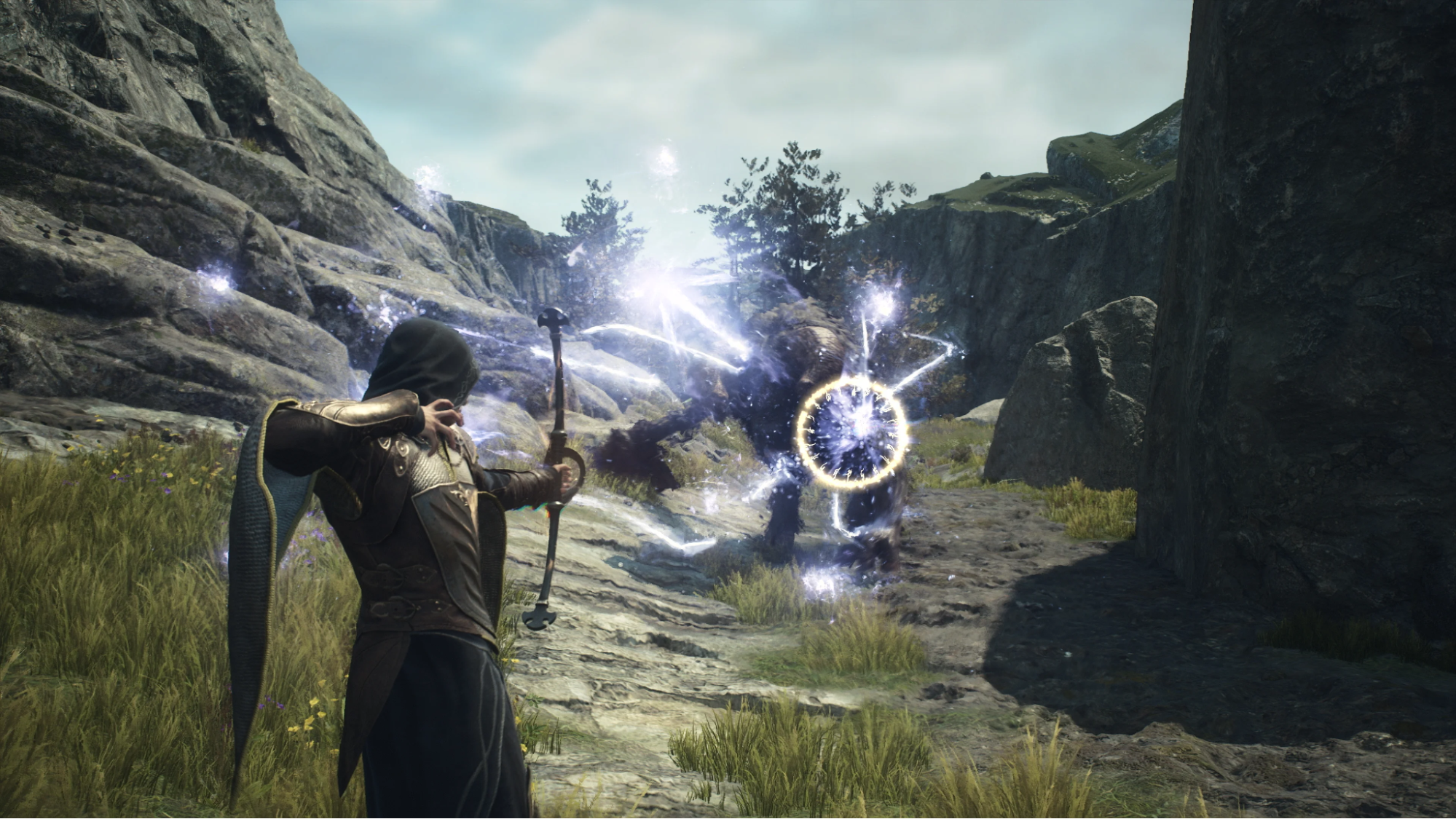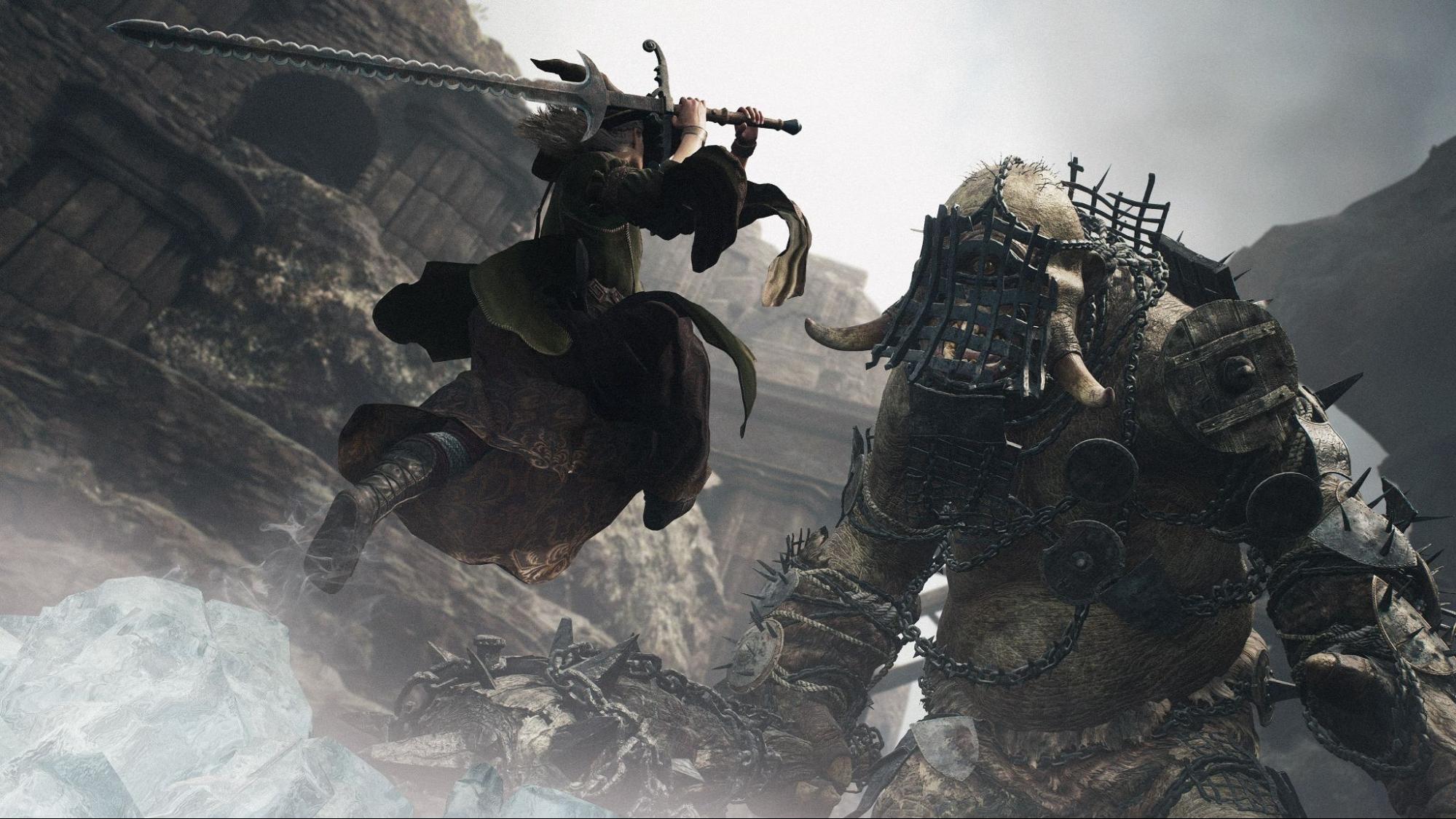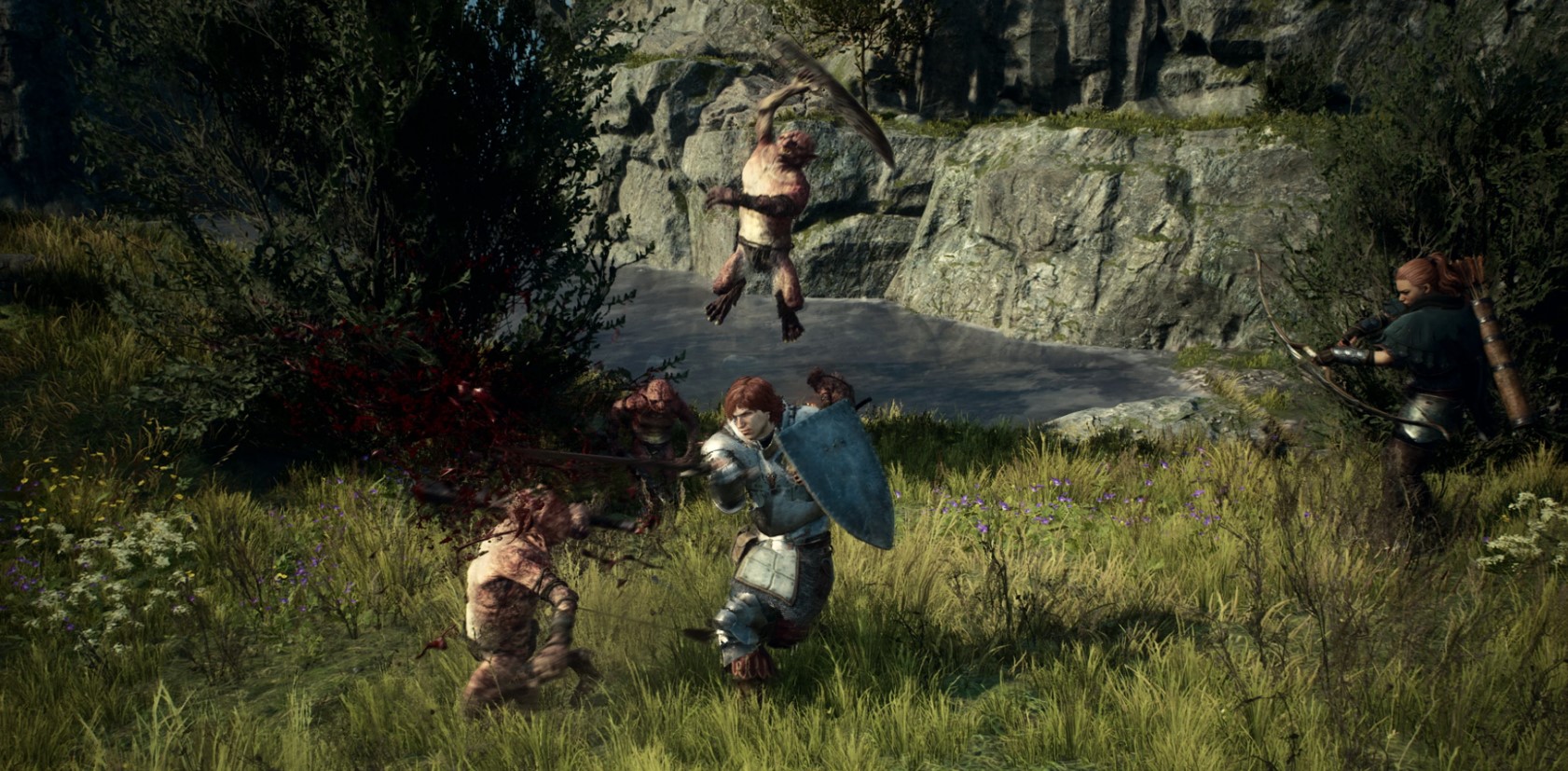The Best Dragon’s Dogma 2 Vocations Tier List
Welcome to our Dragon’s Dogma 2 Tier List that ranks every vocation. I rank each vocation based on damage, survivability, and overall usefulness so you can easily choose the proper one.
Keep in mind that every vocation is without a doubt viable within Dragon’s Dogma 2, even the B and C tier. In fact, I’d even caveat by saying that the B tier is ranked unreasonably low just due to how much stronger the S and A tier is in comparison.
For example, Archer is incredibly weak early but picks up quite heavily late in the game. Most vocations do well throughout the game, with the Trickster falling behind primarily due to its incredibly different style of play.
Dragon’s Dogma 2 Tier List Rankings
| Tier | Dragon’s Dogma 2 Tier List |
|---|---|
| S | Thief, Sorcerer, Magick Archer |
| A | Mystic Spearhand, Warrior, Wayfarer |
| B | Fighter, Archer, Mage |
| C | Trickster |
For a visual reference for our rankings check out our infographic of the best Dragon’s Dogma 2 vocations below:
S Tier
In the S tier, we have our top vocation picks. These vocations excel in one area or multiple in the thief case. You can do no wrong picking an S-tier vocation, and they are so strong that they lean into trivializing the game.
Thief
The Thief is at the top of the S-tier list. It’s safe to say this is the S+ of vocations. I’d say there’s little competition. The vocation excels at defense and offense, and its ability to dodge almost every attack with Formless Feint, a passive whose only downside is that it continually drains stamina, is unparalleled. It’s also obtainable relatively early on in the game. Its damage is also high, and it can deal it consistently due to its ability to reach and flurry weak points.
It also has incredibly high damage abilities like Skull Splitter and Blades of the Pyre, which make you an unstoppable killing machine when mixed with Formless Feint.
The Thief is great fun to play, mobile, and can use specific skills like Concussive Step for world traversal. Although not as helpful as the Sorcerers Levitate, it’s still creative.
Sorcerer
The Sorcerer vocation is a personal favorite of mine as it has unparalleled levels of burst damage. Nothing compares to its ability just to nuke something, and it can do it from early points in the game due to Augural Flare; this skill is fantastic. Its Maister skills are also impressive, both in damage and visually. Meteoron, specifically, is such an incredible skill that does impressive amounts of burst when it hits, and in general, the spells allow you to fulfill that Gandalf-tier power fantasy.
The Sorcerer has undergone some quality-of-life changes compared to its Dragon’s Dogma 1 counterpart. You can use Quickspell to cast many spells significantly quicker and utilize Galvanize to regenerate Stamina, making it feel great to play even in the thick combat. With spells like Levitate, you have unparalleled traversal ability that isn’t given to most other vocations.
With great power comes a squishy vocation, likely the squishiest. Thus, running a Fighter Pawn with this vocation is also optimal. The most significant help, though, was the skill Thundermine, which essentially allows you to control an area by instantly knocking away most lower-class creatures, allowing you to cast in peace.
Magick Archer
Dragon’s Dogma 2 brings back one of the best vocations from the first game, Magick Archer, and it’s no less powerful here. It also brings back some old-time powerful skills, such as Ricochet Seeker, which is unbelievably powerful in tight spaces. The vocation is powerful with skills like Sagittate Avalanche and its Maister skill, Martyr’s Bolt, which sacrifices HP to deal massive damage.
The Magick Archer also has supportive skills, but typically, you’ll run Recovery Arrow to deal with pawn resurrects.
Due to the long-range nature of the vocation, it’s relatively safe to play, and due to its damage output, it deals with threats quickly. Still, running a Fighter Pawn is worth it when using the Magick Archer to draw aggression, giving you the space to do your job.
A Tier
The A Tier are still some of the strongest vocations in the game, almost rivaling that of S, but likely fall short because they don’t excel to such an extreme. For example, the Warrior is an incredibly powerful vocation that does impressive damage and late game can topple and destroy most foes with ease, but he isn’t as effective early as say a Sorcerer or a Thief.
Mystic Spearhand
Mystic Spearhand is the Jedi Knight of the Dragon’s Dogma world. Even though I felt it was a little out of place, it was still an enjoyable and unique vocation to play. While other vocations rely on either Strength or Magick as their primary damage stat, the Mystic Spearhand utilizes both stats.
Its damage comes from its ability to continuously combo and weave in skills, such as its Maister skill, Wild Fury; while the downside to this is burning through stamina, it makes up for this with Ravinours Hond, allowing you to drain an enemy’s stamina and allowing you to get back to DPSing which has a nice flow to it.
Due to its dual stat nature, it uses melee and spell-like ranged skills, efficiently dealing with ranged and melee enemies. It has easy access to ranged attacks through its innate vocation ability, Bolt, which is complex in its own right and a fun skill to use. It allows for range damage and quick crowd control when needed.
The vocation also has access to an incredibly powerful defensive skill called Mirour Shielde, which also applies to Pawns and essentially makes you and your Pawn immune to damage while active. The downside is the short duration and the need to keep it up constantly, so it is not as OP as the Thief skill, Formless Faint, but equally as strong.
Warrior
The Warrior vocation is an insane, Berzerk fantasy-fulfilling vocation. It is immovable, carries a big weapon, and looks good. I enjoyed playing the Warrior early on. The Warrior can feel incredibly slow and may even feel a little clunky, but everything will fall into place once you’ve got a feel for the vocation, and that’s all you need, as the vocation is powerful right off the bat; it just takes getting used to.
You can hinder and interrupt most enemies with the Warrior, which gives the player a lot of openings for swings, which you’ll need as these are slow and weighty but powerful. Heavenward Sunder is the first ability you can access, which opens up the enemy and can knock enemies down; this does impressive damage. This is also nicely paired with Indomitable Lash, which looks like an execution-style slam, which looks great against knocked-down enemies. Later, this can be changed out for Arc of Might for an actual execution when fully charged against a weak spot on a knocked enemy devastating 1-2 health bars.
Wayfarer
The Wayfarer is a vocation whose Tier I debated. It simultaneously loses a lot while gaining a lot, leading to a love/hate relationship with many players.
The vocation can use every other vocation’s weapons and armor and can pick and use any skill for those weapons. This essentially allows it to “combo” weapon skills at the sacrifice of one skill, which has to be dedicated to its innate skill, Rearmament, which you use to cycle through your different weapons, and also loses the ability to use Maister skills.
This allows you to use a Bow with Bow skills and then switch to a Dagger and climb and grapple monsters, allowing you to engage in ranged and melee combat freely, but this doesn’t work in practice. Most vocations have a broken ability that you’ll typically just spam, making the vocations’ perceived strength useless in practice, except in one particular case.
One of the best skills available is the Sorcerer skill Augural Flare. The more you hit Augural Flare, the more damage it deals. The vocation with the highest attacks per turn is the Thief, so combining Staff and Dagger is incredible. It allows you to cast Augural Flare and do massive damage by hitting it with Daggers.
Another point in favor of this vocation is its ability to rank every other vocation simultaneously, allowing you to play Wayfarer while ranking up every other vocation. This was amazing for me, as there were particular vocations like the Mage that I wanted to avoid playing due to their more supportive playstyle.
I couldn’t end without mentioning that this vocation can use the gear of every vocation, which is peak Fashion Dogma.
B Tier
B-Tier is essentially the tier I’d label “Balanced.” These don’t have the sheer power as the other vocations or are deceptively powerful due to some gimmick utilized more late game than early game. An example is the Archer, who has skills requiring arrows. One of these is Blighted Arrows, which do incredible damage when used in pairs as they can cause nasty poison debilitation. The downside is that they’re expensive and thus can not be freely used early.
Fighter
The Fighter is the stereotypical Knight of Dragon’s Dogma 2 and is also the vocation that absorbed some of the Mystic Knight’s elemental counter abilities from the first game. In that vein, the Fighter can pull the aggro of monsters from Pawns, or the player, if the Pawn is a Fighter, this sets you up to use the vocation-specific ability to block damage and counterattack.
It’s an impressively fluid style of play that is a bit similar to a typical souls-like game as the block is directional, so it requires skill and awareness to get right.
Shield Drum is the skill you’ll use to Taunt, but a note I think worth mentioning is that in Dragon’s Dogma, the AI has a tendency to focus you, the player, so it’s viable to fo-go this skill entirely as it’s likely the AI will already be focusing you. That said, it is an essential skill for Pawn Fighters as it will allow them to take monster focus from the player.
The vocation also does decent damage by countering; one of these counter skills is Vengeful Slash, which allows you to slash in an AOE after blocking an attack. When enemies are open, typically after being countered, you can also empale smaller creatures to execute them quickly. Later, the Fighter’s Maister skill, Riotous Fury, allows him to dish out massive damage, especially against weak spots- but it’s best used on downed creatures.
Archer
The Archer is the vocation I started playing when I stepped into Dragon’s Dogma 2. It’s not as powerful as the other vocations on this list, and I think its rating accurately reflects that; it’s a vocation I think could potentially be buffed a little just so its power curve reflects other vocations on the list. It relies heavily on a decent weapon, so finding a decent bow and upgrading it goes a long way.
The early game is where this vocation doesn’t shine, as you don’t have access to many solid abilities, and you likely haven’t collected any Arrows that you can use with their associated skills when you eventually pick them up. It’s still a ranged vocation, so you can sit back and pepper enemies from a distance, and a Fighter Pawn goes a long way here.
Later, the Archer shines, gaining access to the Spiral Arrow, an incredible skill that can be continually cast and fired for multiple Spiral Arrows. The power of this skill comes from its many hits, which will continually hit with any element you have on your weapon, allowing for that debilitation to take effect. It also has the added effect of holding smaller creatures in place and even halting creatures from casting.
Arrows and associated Arrow skills are also where the Archer’s gameplay is. These can be bought, crafted, or found. You will have access to an array of Arrows, such as Explosive Arrows, that are used by the skill Explosive Shot, which allows you to shoot an arrow that will either explode with time or can be shot to force it to detonate early, this deals impressive damage. You also have Blighted Shot, which requires Blighted Arrows to apply poison, but if you hit a target twice with these arrows, you’ll apply Fulminant Poison, which will deal with severe poison/tick damage. I’ve seen this rip through Dragons HP bar.
Mage
The Mage is an excellent support vocation, and in that area of play, it’s S, but it’s typically something you relegate your Pawn to doing. Putting this in the same category as Magick Archer or Mystic Spearhand just isn’t it.
It’s excellent at what it does. It has impressive healing with Andoyne and Argent Succor and a skill called Palladium that protects everyone against one attack.
It’s also got basic attack skills, but where this vocation shines is its Maister skill, Celestial Paean, which hastens all players and increases the stamina recovery of all allies within its range by a massive amount—and the range itself is enormous. Essentially, this gives allies in the area infinite stamina, allowing Mystic Spearhands and Thiefs to just go crazy on their damage skills.
Letting a Pawn take this vocation with the Celestial Paean is the optimal play. The Pawn will use Celestial Paean every chance it gets, which isn’t optimal, but this isn’t much of an issue as they’ll use it again the next fight, allowing you to go to town as soon as it’s cast.
C Tier
Trickster
The Trickster is a unique vocation and a completely new one to Dragon’s Dogma, which sports an entirely new set of skills with its own associated weapon. It’s primarily a supportive vocation, almost to a fault, as you don’t deal damage- which seems counterproductive in Dragon’s Dogma, and it kind of is.
That doesn’t make it useless, but it’s an acquired style of play that I’m betting will likely be the vocation that people will break the game with eventually.
It’s also by no means a “weak” vocation. Its strengths lie heavily in its ability to mass taunt and buff pawns, and your pawns will be your primary source of damage. This vocation is the one that relies the most on Pawns.
Essentially, this vocation summons a spirit or illusion that can be placed or set to follow you. You can then force enemies to attack it using Suffocating Shroud, giving your Pawns free rain to dish out damage. Your secondary goal is buffing allies with skills like Aromatic Rally/Resurgence, which boosts your pawn’s offensive capabilities.
The vocation is like a tactician or commander and has a much more passive playstyle than every other vocation.
 Download APP
Download APP
